“A rising tide lifts all boats” is the best phrase you can use to describe the current Porsche market. The 911 in all of its forms is currently one of the most highly desired sports cars on the planet, and prices have steadily risen to irrational levels. Looking for alternatives, buyers have busied themselves with buying up everything else they can with the Porsche name on it. If you can’t have an early 911, then there is another choice that will not likely lose value when the used Porsche market eventually implodes. This found by reader James 1971 Porsche 914-6, is being sold on eBay out of Mc Kinney, Texas. It is one of just a handful of 914s produced with the famous Porsche flat six in the cramped engine bay. With bidding on this fairly solid example currently at $35,000 with four days to go, would this little sports car be the best place to park your Porsche money?
Born in a handshake agreement between Porsche and Volkswagen, the 914 was to replace both the 912 and the Karman Ghia. The handshake deal soon fell apart after one of the hand shakers, Volkswagen chairman Heinz Nordhoff, unexpectedly died. When things finally shook out, it was agreed that the cars would be sold as Porsches in America. Two versions hit showrooms in 1970, a four cylinder car with a Volkswagen engine, and a six cylinder version with a Porsche powerplant. While the design was revolutionary, the straight line performance wasn’t anything to write home about. The handling was better than that of the 911. Sadly, the six cylinder version lasted just two years and the four cylinder car held on until 1976.
Porsche owners in the United States looked down upon the 914 as more Volkswagen than Porsche. Another problem was that Volkswagen charged Porsche an exorbitant fee of bodies used to produce the 914-6. This made the cost of the better handling car slightly less than the lowest priced 911. Only 3,351 six cylinder cars were produced as a result. The four cylinder version, however, was the most popular Porsche built to that time. Over 118,000 were sold, and many are still on the road today. Despite their lack of respect when new, there are a number die hard 914 fans out there. This includes myself, as I had a 1974 914 in high school. Nothing goes around corners as well. Imagine a go cart on steroids.
Had Porsche given the 914 the development that other Porsche models benefitted from, their reputation would have improved exponentially. Still, you can’t help but think the Cayman is the car’s spiritual successor. It too suffers from an unwritten corporate edict that the 911 is the premier sports car at Porsche. If both it and the 914 were gifted the most powerful engines in the 911 line, which would fit easily, far fewer 911s would be sold. As Porsche made a lot more money per car on the 911, you can see why the 914-6 never achieved its potential. Can you imagine how beastly an evolved 914 with a 930 turbo engine in it would have been?
Despite these lost opportunities that have come and gone, the surviving examples of the 914-6 have always demanded a large premium over more pedestrian 914s. The presence of the Porsche flat six legitimizes them in the eyes of hard core Porsche collectors. The example we see here is fairly solid for a 914 of this vintage. If you look at the ad and scroll through the pictures below the seller’s description, you can see a fair amount of surface rust throughout the car. There are rust through problems in the floor pans and where the pans attach to the sills. This is to be expected, as corrosion was a real issue for these cars.
Thankfully, this 914 still retains its original, numbers matching engine. The bad news is that it only put out 109 horsepower in 1970. The good news is that the car weighed just 2,172 lbs and this engine could take it all the way to around 130 mph. At the time, reviewers liked the 914-6 a lot better than they did the 914. Granted, the anemic 1.7 liter flat four in the 914 had about 30 less horsepower that didn’t rev as high or put out those wonderful Porsche sounds. Criticism of the vague shifting five speed transmission (fixed in 1973) and the cheap immovable passenger seat (fixed in late 1972) were justified on a car that cost this much.
Is this car worth the $35,000 it has been bid to, or even the assumed loftier reserve? If you have your heart set on an early seventies Porsche, and you have the stomach for what would likely be a costly restoration, then the answer is yes. 914-6 Porsches have always been desirable, and their value has steadily risen since they stopped being just used cars. They are better performers in every way than the standard 911 of the time. With some modifications to the engine, these cars are giant killers.
Much of what you need to perform a correct restoration is present. It is the little things that eats you alive. A set of reproduction heat exchangers will cost you around $3,000. Another costly replacement is the rubber around the targa top and the doors. You would also have to cut out the floor pans and replace them, which is not an easy task if there is rust in the sills as well.
If you are looking to take advantage of the performance that the platform can offer, it doesn’t make sense to use this rare and expensive car as a base point. You could make a giant killer out of a standard 914 by either modifying a later 2.0 liter flat four, putting on fender flares and wider tires, and beefing up the suspension. There is even a company making kits to drop an LS engine in a 914. You would be limited to what a 914 5 speed transmission could endure, but I doubt you would lose many street races.
The car is worth restoring and likely worth the $35,000 it is at right now considering the market. A restoration could double that price if it were completely farmed out. At that point, it it is not worth what you have in it, it will be soon.
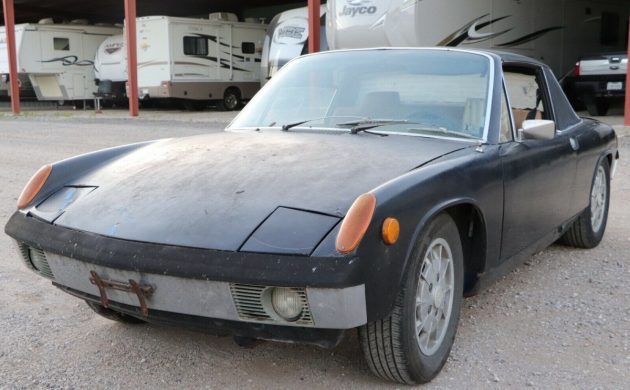
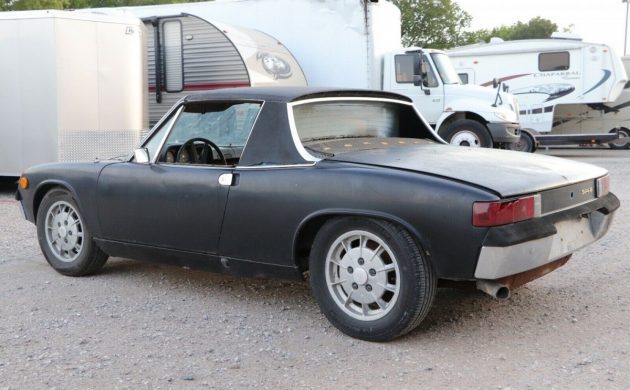
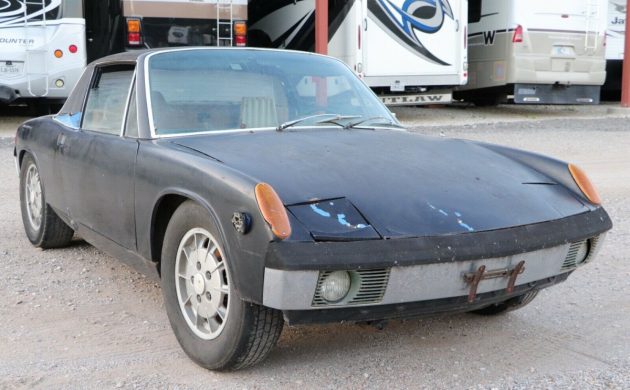
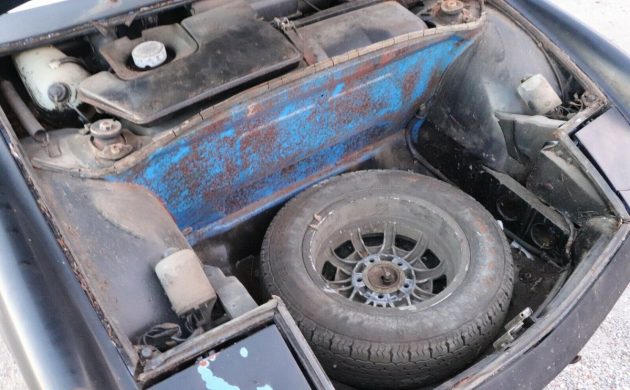
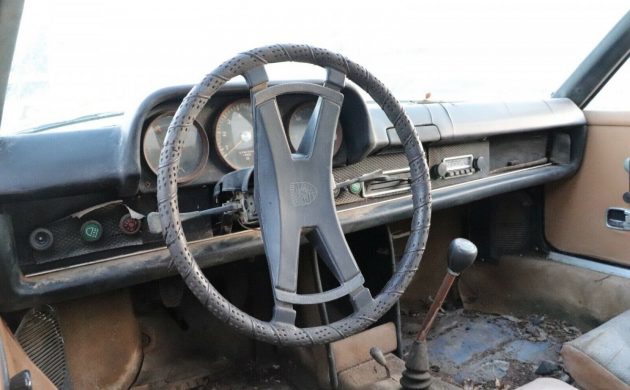
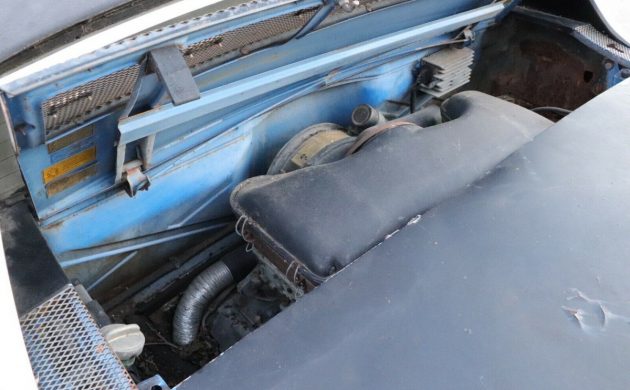


Assuming that there is no rust in the so-called “hell hole” area immediately in front of the battery where the firewall meets the suspension consul this looks like a screaming deal.
The hard to find early 1970 914 and all of 1970/6 rear bumper is present.
The impossible to find rear valance is present.
It has the very desirable Mahle forged magniseum “gas burner” wheels that weigh 9 pounds apiece, the lightest Porsche wheels ever made.
The paint and interior are awful but it costs the same to fix just tired as to fix awful.
If you are going to restore this or build a 914/6 GT clone it’s a bargain.
I guess I’m getting old if this is a bargain.
I agree. This is no “bargain”. This is 3x overpriced in my opinion. I’d rather have a 911 at this price, at least the 911 isn’t fugly like the 914…lol
The Porsche madness continues!
I’m simply appalled,,what is wrong with these people? Ok, I’m not a Porsche fan, and the 914 was my least favorite, but if I’m not mistaken, this was the hottest 914 you could buy, and not many were sold, making it “Grail” worthy, and some doofus trashes one? I remember, years ago at Road America, these things dominated the track, and the sound was unmistakable. Such a shame it looks like this, they are fantastic cars.
Rube – I was a regular at Road America until recently, and I’ve seen lots of great cars there. That doesn’t make me a fan of the 914-6. I went to the local VW/Porsche dealership in ’71, after a stint in the Army in Germany. I brought the ’67 Fairlane GTA back with me as none of the Germans in my area wanted an automatic. (I’d already sold my ’57 Fiat 500 and ’68 Lotus Europa). A close friend had a ’67 911, and I got to drive that a bit. Anyway, wasn’t thrilled with the 914-4 or 6 (and indeed they were gouging re: price) tried the 911T as well. My practical side stepped in. Bought a VW for my German wife and went up the street and ordered a BOSS 351. Have I ever regretted that choice. Nope.
Auction states: “recently out of long term ownership”. More like recently out of long term neglect.
I like the rope they used to tie down the spare tire. Class.
A correction on Ebay now says the car is a 1970. Not sure if exact year will matter price wise. Nice car but will not be cheap to restore. But when finished, it should turn a lot of heads.
It doesn’t impact the price. The 70 and 71 are both rare and I don’t believe there were any changes between the two years. The first few 914-6 had the fenders flush-welded to each other, so you won’t see any seam separating the front fenders from the font valences, etc. I don’t think more than a few dozen rolled-off the assembly line like that.
BTW the vin on this is 9140432124. The 4th digit “0” is the code for a ’70. a ’71 would have “1” as the 4th digit.
My favorite car I have owned was a ’71 914. If I had unlimited funds, I would buy and restore one. I don’t, however. I’m not sure it would be a good idea anyway; you really can’t go back. Nothing can replace that first ride with the targa roof off, exhaust screaming out of the header, as I whipped that go kart around the turns. So a little smoke came out of the defroster; didn’t matter. The only people who trash talk 914s are the ones who haven’t driven one. Moving up from a beetle to the 914 for me was like going from a Cessna to a F-16.
Our second and last 914 was a ’74 built from the ground up with reinforced chassis, modified suspension, etc. with the idea of putting a six in it. The 4 cylinder we built was so good that we never got around to it. Sold it to a friend as a rolling chassis and he put a modified 2.7 six in it. Did the initial test drive with him and I can tell you it was a blast to drive. Stock the original sixes don’t have a lot of power or handle that well but it’s easy to solve those issues and well worth the effort.
I thought 914-6’s had different fenders and quarter panels that were slightly flared. This looks like it has standard, straight fenders.
Steve R
Nope, 914-6’s had the same fenders as the regular 914’s.
Steve, you’re thinking of the 914-6 GT or M471 option, of which only around 400 were built.
Jeepster, I believe it was 48 of the GT cars. Even more rare would be the 916 (11 made).
I love to drive these with the modified suspension Dave Finch developed, wow! Really this is another case of neglect, and better off buying the really nice one instead of restoring this or buy a nice 911 and enjoy driving now instead of years of the resto process needed here. I’ll guess the buyer will get stung BIG time when the market turns around. Ouch!
While a number’s matching 914-6 grows even further towards the outer reaches of the rich man’s game, the truly great news is that you can still find a beat up old 914 in almost any local cl post for $1500 or less, and make it into whatever you want. Whether this 6 is worth it or not, this write up was worth every word. Thanks for doing this wonderful little car justice!
I had a ’71 914 with the 4 cyl. engine. It was a cheap Porsche and it handled extremely well. Even though I live in Houston Texas this wannabe Porsche just rusted itself to death after 10 years! The only reminder of this car is the 4 cyl. engine and trans. This specimen seems to be a rust bucket and a money pit. Forget about it!
I have owned 3 914-6’s and presently own a ’71 914-6 which is just completing a complete rotisserie restoration down to every last nut and bolt. 914-6’s were actually made over 3 years- ’70, ’71 and ’72. The largest number were made in ’70, approximately 2,700 then in ’71 they made just shy of 450 and in ’72 they made about 250. The ’72 had fewer unique 914-6 parts as they were ending the run. For instance, on ’70 & ’71 the ignition switch is to the left of the steering wheel down by the head light switch. In ’72 it was on the column like all of the 914-4 cars came. I like the ’71 model year the best as it was a limited production run and still had the ignition switch where it belonged, to the left of the steering wheel. I have owned 5 911’s ranging from early ’70’s to having just sold a ’10 997.2 4S 6 speed coupe. I never got the thrill driving those that I always get driving a Six. Best handling cars I have ever driven. So, for me, the 914-6 is a driver’s car and that is what I like and enjoy. I hope this car gets the restoration it needs to live on for another 50 years. Cheers, Michael